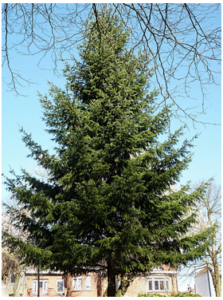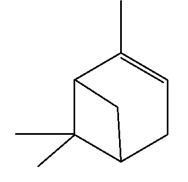- About Us
- Our Work
- Tree Info
- Get Involved
- Blog
- Support Us
By Canopy Team on June 4, 2018

Photo by Elise Willis
Tree Spotlight Series: Follow along in this series as we learn about the fascinating trees that live among us. This series is in partnership with Rhee Lab in the Plant Biology Department of the Carnegie Institution for Science.
Read the first post in this series featuring the Ginkgo biloba.

The Douglas fir (Pseudotsuga menziesii) has been the most popular Christmas tree in America since the 1920s. The tree grows big and lush, making it an ideal for Christmas. It is a member of the pine family that is native to Western Canada and the Pacific Northwest United States.
The tree can grow to be extremely large—mature trees can be anywhere between 65 and 300 feet tall! The Douglas fir has long, thin leaves that circle the entire branch. The cones of female trees have characteristic three-pronged bracts (specialized leaves) growing between them that resemble the hind legs and tail of a mouse.
The common name “Douglas fir” is misleading, as this tree is not actually a fir at all. True firs (members of the genus Abies) have cones that grow straight upwards like candles, and the scales of the cones fall away as the cone matures. By contrast, the cones of the Douglas fir hang downwards and open when they mature, but do not dissipate.

The epithet menziesii is named after Archibald Menzies, a Scottish physician and naturalist who first described the species on an expedition to Vancouver Island in 1791. The common name refers to the British botanist David Douglas, a rival of Menzies, who brought the tree back to Britain after an exploration of the Pacific Northwest in 1827.
David Douglas was a well-respected botanist, an accomplished explorer, and a mountaineer. He brought hundreds of species of plants from Hawaii and the Pacific Northwest back to Britain, including many conifers like the Douglas fir that were cultivated around the world for their wood. Despite his great success, he met an untimely death at the age of 35 while climbing a volcano in Hawaii. He was fondly remembered—many species of flora and fauna were named after him.

Douglas firs and other pine trees have a distinct, pleasant smell that may remind you of Christmas tree pop-up lots. This smell is caused by pinene, a volatile compound produced by pine trees (Figure 3). A volatile compound is a carbon-containing molecule that quickly evaporates and often produce scents. Pinene is one of the compounds that make up pine resin, a sticky substance produced by the tree as protection when its bark is damaged. Resin is also harvested from pine trees to make varnishes, adhesives, and perfumes.
Today, the Douglas fir is one of the most economically important trees in the United States. The hardness of the tree’s wood and its resistance to wear makes it useful for heavy construction, such as furniture, bridge parts, building struts. Along with its use in the lumber industry and its presence in our homes during the holidays, its majestic beauty makes it loved by people year-round.

Galyna Vakulenko is a 2018 summer intern at the Rhee Lab in the Plant Biology Department of the Carnegie Institution for Science at Stanford University. She is an undergraduate student majoring in plant physiology at Carleton University in Ottawa, Canada.